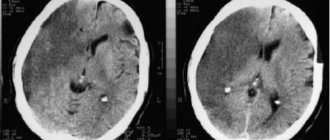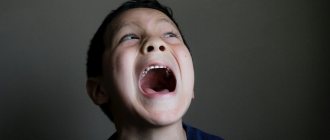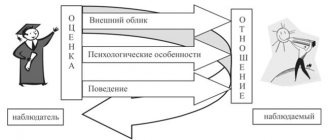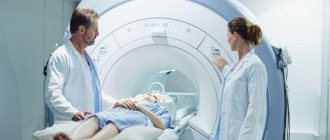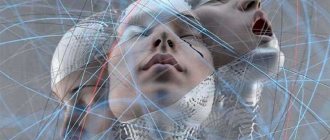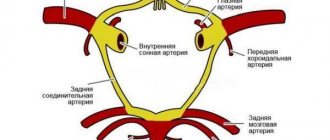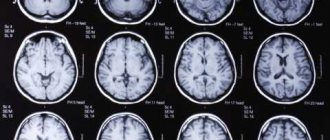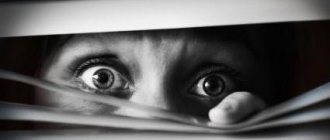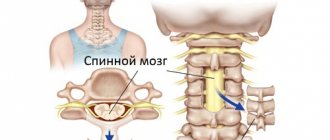Cerebellar ataxia develops as a consequence of damage to the cerebellum or neural connections between this part of the brain and the peripheral nervous system. The pathology is accompanied by deterioration in motor coordination, visual dysfunction, and speech impairment. Since the cerebellum is involved in controlling muscle activity and cognitive functions, damage to its tissue negatively affects mental and motor activity, especially walking and fine motor skills.
Causes
Normally, voluntary movements are ensured by precise coordination between synergistic and antagonistic muscles. The interaction between them is controlled by the cerebellum, which has connections with all structures of the central nervous system that take part in motor function. The cerebellum can be called the main coordination center of movement; it receives information from brain structures and ensures the synchrony and accuracy of muscle contractions, also processing information about the movement of the body in space. This ensures the accuracy and smoothness of voluntary movements. When the cerebellum is damaged, desynchronization of muscle contractions of different groups occurs, which is manifested by ataxia.
The causes of cerebellar damage may be as follows:
- acute cerebrovascular accident (stroke) affecting the cerebellum;
- traumatic brain injury;
- infectious cerebellitis, including parasitic origin;
- cerebellar abscess;
- acute and chronic intoxication, including drugs (anticonvulsants, hypnotics, anxiolytics, neuroleptics, bismuth drugs, chemotherapeutic drugs, etc.);
- alcoholism;
- deficiency of vitamins B1, B12, E;
- heatstroke;
- hypoglycemia;
- hypothyroidism;
- multiple sclerosis;
- Arnold-Chiari anomalies;
- channelopathies (diseases caused by genetically determined defects in ion channels);
- genetic diseases (Friedreich's ataxia);
- prion diseases;
- tumors (medulloblastoma, cerebellopontine schwannoma and hemangioblastoma especially often affect the cerebellum);
- paraneoplastic degeneration of the cerebellum (secondary tumor lesion of the cerebellum);
- Hakimi-Adams syndrome (normotensive hydrocephalus);
- mitochondrial encephalomyopathies (Leigh's disease, MELAS syndrome, etc.);
- idiopathic degenerative ataxia caused by neurodegenerative diseases (parenchymal cortical cerebellar atrophy, multiple system atrophy, hereditary cerebellar ataxia Pierre-Marie);
- hereditary and genetic metabolic disorders (aciduria, Hartnup disease, Gaucher disease type 3, Tay-Sachs disease, Refsum disease, etc.).
Physiotherapy
Patients are prescribed therapeutic exercises to strengthen muscles and improve coordination of movements.
Patients with Pierre-Marie ataxia benefit from balance exercises. First, tasks are performed in a sitting position. This could be training precision movements, turning the body, lifting and moving objects. Gradually, the exercises become more difficult, reducing the plane of the seat support.
Then the person makes movements with his legs, holding onto the bars with his hands. When the patient manages to maintain balance in this position, you can move on to walking. The patient tries to walk, making movements with his arms, moving his back or side.
Patients with oculomotor disorders benefit from visual exercises. The patient tries to fix his gaze on a certain object or point, while changing the position of his head and body.
Forms of cerebellar ataxia
Different parts of the cerebellum (vermis and hemispheres) are responsible for different types of movements; In accordance with the predominant damage to one or another anatomical structure of the organ, two forms of pathology are distinguished:
- dynamic – caused by damage to the hemispheres, characterized by incoordination of movements in the limbs;
- static-locomotor - caused by damage to the worm, as a result, gait is disrupted and stability suffers.
In addition, cerebellar ataxia can be:
- acute – caused by acute causes, for example, stroke or traumatic brain injury;
- chronic - caused by long-term lesions of the cerebellum, for example, in chronic alcoholism.
By nature of distribution:
- generalized – all voluntary movements are impaired;
- isolated – some types of movements are impaired, for example, walking, speaking, hand movements.
Ataxia can also be unilateral or bilateral.
Clinical signs
The symptom complex of cerebellar ataxia takes first place in the clinic. Patients are characterized by static disorder - falling backward or to the sides in the Romberg stance. A slight disturbance in gait, “shooting” pain in the legs and lower back indicate the onset of the disease. Next, tremors of the hands, head, and unconscious contractions of the muscles of the face and torso occur. With a significant decrease in muscle strength, sensitivity remains. The clinic is accompanied by a lack of coordination of movements, handwriting becomes large, uneven and sweeping. Speech becomes difficult, becomes intermittent and slow, and has a chanting character.
Classic clinical cases are not without oculomotor disorders and decreased visual function. The gradual death of the optic nerves leads to a narrowing of the visual fields. All these signs are steadily progressing. Drooping of the upper eyelid is recorded. The patient raises his eyebrows in an attempt to reduce ptosis - this gives the face a surprised look. Often the disease is expressed by strabismus, impaired binocular vision, which leads to paresis of the abducens nerve.
Mental ailments are gradually joining the listed disorders. The course of the disease is aggravated by a decrease in mental processes and memory, and a depressive neurotic state develops. In severe clinical cases, epileptic seizures occur.
Symptoms of cerebellar ataxia
The manifestations of cerebellar ataxia depend on which particular cerebellar structure has been damaged.
Cerebellar ataxia is characterized by impaired coordination of voluntary movements
When the worm is affected, the ability to maintain a stable body position is impaired; the patient sways in a standing position; for stability, he has to balance with his hands and spread his legs wide apart, otherwise he may fall back. The gait resembles the gait of a drunken person, it is uncertain, the patient is especially unstable when turning, he staggers, his torso is sharply straightened, his legs rise too high while walking.
When the hemispheres are affected, gait disturbance and unstable body position may also be observed, with the patient “falling over” to the affected side. The main manifestation is awkward and uncoordinated movements of the limbs, preventing the performance of precise actions.
Mildly expressed ataxia is checked using functional tests, and severely expressed ataxia sometimes does not allow a person to walk at all, and in some cases he cannot stand or even sit.
As the condition progresses, the described disorders are joined by dysphagia (impaired swallowing) and dysarthria (impaired speech).
Signs of ataxia are accompanied by symptoms characteristic of the underlying disease.
Symptoms of the disease
Primary symptoms of cerebellar (cerebellar) ataxia include an unsteady, unstable, unsteady gait with a noticeable expansion of the support base, lack of coordination, angularity, and clumsiness of movements. Other signs:
- Dysarthria. Scanned, slow, abrupt speech.
- Dysmetria (excessive or insufficient range of motion).
- Oculomotor disorders. Nystagmus (usually horizontal) – fast, frequent oscillations of the eyeballs, dysmetria of saccades (fast, coordinated eye movements).
Patients usually stand with their feet wide apart. An attempt to bring the feet closer to each other ends in loss of balance, swaying, and sometimes falling. Due to imbalance regulation, it is necessary to rely on surrounding objects or the support of another person. Mechanical movement in a straight line helps to identify the slightest gait disturbances.
Symptoms of cerebellar (cerebellar) ataxia are often supplemented by such signs as muscle hypotonia (weakness), slowness during movements, intention tremor (a disorder of fine motor skills of the limbs, which manifests itself as trembling and occurs after the completion of a voluntary movement), which is taken into account when determining treatment tactics. Symptoms are often observed:
- Asynergy. Deterioration in the ability to perform voluntary movements of a combined (consistent) nature.
- Strengthening postural reflexes (a set of reactions that occur to maintain a given position in space of a part of the body or the entire body).
- Deterioration of cognitive abilities, affective disorders provoked by damage to the ischemic etiology of the posterior parts of the cerebellum.
Impaired motor activity in cerebellar ataxia often does not correlate with muscle weakness, hyperkinesis (pathological, sudden movements provoked by an erroneous command from the brain), spasticity. However, such manifestations of pathology complicate the clinical picture. If the damage to the cerebellar vermis is partial, a pathological change in the function of standing and walking is observed.
Rostral lesions (the initial parts of the worm) lead to deviation of the body and a fall in the forward direction. Caudal lesions (caudal sections of the worm) initiate deviation of the body and fall in a backward direction. In the unilateral form, patients stagger and their ipsilateral shoulder (located on the side of the affected part of the cerebellum) is slightly drooping. When moving, patients deviate towards the affected area.
When neuronal pathways are damaged, rough tremor of the upper extremities is more often observed in a standing position with straight arms extended forward. Often, such destructive processes are associated with multiple sclerosis, which leads to damage to nerve endings and a deterioration in the transmission of nerve impulses.
Diagnostics
When symptoms of ataxia appear, the patient undergoes a neurological examination. It is required not only to confirm the cerebellar nature of the pathology, but also to identify the condition that led to its development.
In case of unexpressed symptoms, coordination (functional) tests are performed, for example:
| Try | Description |
| Checking ground reaction | The patient is asked to stand with his feet together. It is difficult to maintain this position during ataxia; the patient will stagger and lose stability. |
| Checking stability in the Romberg pose | The patient is asked to stand with feet tightly together, head elevated, and arms extended forward. Ataxia is manifested by instability of body position, the patient begins to sway and may fall. |
| Checking stability in the sensitized (complicated) Romberg position | The patient is asked to stand so that the toe of one foot rests on the heel of the other foot, while slightly raising his head and extending his arms. With ataxia, he will not be able to maintain stability even for a short time. |
| Checking the jump reaction | Normally, if a person standing with his legs together is in danger of falling to the side, the leg on that side moves in the direction of the fall, and the other leg comes off the floor. In case of ataxia, the doctor stands behind the patient and, holding him for safety, pushes him to the side. With ataxia, even a small push will cause a fall; this is the so-called positive symptom of pushing. |
For confirmed ataxia, the following is prescribed:
- neuroimaging studies: CT (computed tomography of the brain), MRI (magnetic resonance imaging of the brain);
- neurophysiological studies: electroneuromyography, evoked potential method.
Using these methods, functional and structural changes in the central and peripheral nervous system are determined.
If hereditary atactic diseases are suspected, the patients' DNA is analyzed. If necessary, the patient or his relatives are referred for medical genetic counseling. If there is reason to suspect a hereditary pathology in the fetus, a prenatal DNA test is performed.
A thorough search for the causes of ataxia may include a wide range of studies, including imaging techniques (search for tumors), blood tests for hormones (search for endocrine disorders), biochemical studies (search for metabolic disorders), toxicological analysis (search for possible intoxications), etc. Patient may be referred for consultation to related specialists - cardiologist, endocrinologist, neurosurgeon and others.
It is important to start treatment on time!
Cerebellar ataxia is a serious disorder that requires immediate action; treatment is carried out by a neurologist.
It is most often symptomatic and covers the following areas:
- restorative therapy (prescription of cholinesterase inhibitors, Cerebrolysin, B vitamins);
- physiotherapy, the purpose of which is to prevent various complications (muscle atrophy, contracture), improve gait and coordination, and maintain physical fitness.
Training complex
A gymnastic complex consisting of exercise therapy exercises is prescribed.
The goal of the training is to reduce incoordination and strengthen muscles.
With surgical treatment (elimination of cerebellar tumors), partial or complete recovery or cessation of the development of the disease can be expected.
In Friedreich's ataxia, drugs aimed at maintaining mitochondrial functions (vitamin E, Riboflavin) play an important role.
If the pathology is a consequence of an infectious disease of the nervous system, treatment for this infection is mandatory. The doctor prescribes drugs that improve cerebral circulation, nootropics, betahistine.
A special massage helps reduce the severity of symptoms.
Treatment of cerebellar ataxia
Therapeutic tactics depend on the cause of ataxia; efforts are aimed at treating the underlying disease. For example, if the cause of the pathology is a resectable tumor, treatment will be surgical, and if unresectable - chemotherapy or radiotherapy, if the cause is hypovitaminosis, vitamin therapy is prescribed, treatment of traumatic brain injuries is carried out according to the scheme adopted for this type of injury, and therapy for multiple sclerosis consists in taking immunomodulatory drugs. In such cases, treatment of the underlying disease is usually sufficient for the symptoms of cerebellar ataxia to completely disappear or at least stop progressing and decrease.
There is information in the literature about the successful use of certain drugs (pregabalin, amantadine, thyrotropin-releasing factor, buspirone, L-5-hydroxytryptophan) for ataxia of degenerative etiology, but there have been no clinical studies that could confirm this information. There is also data on the effectiveness of inosiazide and a number of anticonvulsants (carbamazepine, clonazepam, topiramate) for cerebellar ataxia, but these data also need to be verified and confirmed.
Currently, scientific research is being conducted on the treatment of ataxias of hereditary origin using cell and gene therapy methods; these areas are assessed as the most promising in solving this problem.
Physiotherapy
This is one of the key methods of treatment and rehabilitation of patients with cerebellar ataxia. Physiotherapy can improve coordination, support motor functions, and prevent the development of muscle atrophy and contractures. Complex programs have been developed, including exercises aimed at restoring feedback, special exercises for training the functions of the cerebellum (Frenkel method), proprioceptive muscle facilitation (PMF, proprioceptive muscle facilitation).
There are special exercises that help stimulate the functions of the cerebellum.
The greatest effect can be achieved with the combined use of medication and physical therapy.
Spinocerebellar ataxia in a child
Spinocerebellar ataxia is a neurodegenerative pathology that combines several types of autosomal dominant diseases, each of which is considered separately. A feature of the pathology is the rapid increase in clinical manifestations. Symptoms of ataxia include: awkwardness of movements and unsteadiness during gait, tremors of the hands, inability to perform precise movements. As the disease progresses, problems with urination arise, muscle atrophy and paralysis occur.
On our website you will find more information on the topic “spinocerebellar ataxia in a child” and you can make an appointment with a doctor. Reception is conducted by specialists of the highest category.
The consequences can be the saddest
Complications of ataxia may include:
- tendency to recurrent infections;
- chronic heart failure;
- respiratory failure.
Forecast
It is impossible to completely cure cerebellar ataxia.
The prognosis is rather unfavorable, since the disease tends to progress rapidly . The disease significantly impairs the quality of life and leads to numerous organ disorders.
Cerebellar ataxia is a very serious disease. At the first symptoms, you must immediately contact a specialist for a comprehensive examination.
If the diagnosis is confirmed, timely adoption of measures will significantly alleviate the patient’s condition in the future and slow down the progression of the disease.
